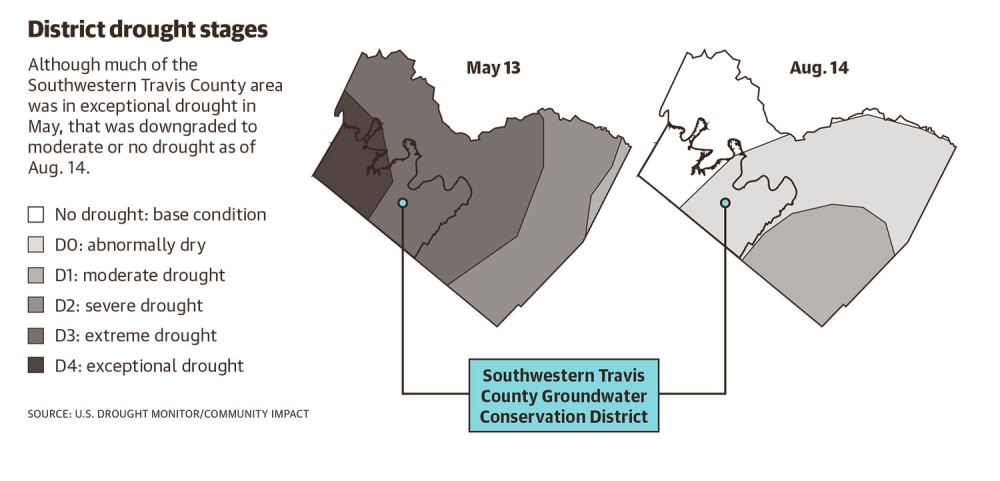Heavy rainfall resulted in upstream floodgates opening, and in the span of one month, Lake Travis went from 43% to 90% full, according to data from the Lower Colorado River Authority on Aug. 8. After years of low lake levels, local water authorities and community members have said safeguarding these new water resources is top of mind as recovery and cleanup efforts continue.
Current situation
After the July 4 weekend rainfall increased Lake Travis’ water levels, Hurst Harbor Marina General Manager Nick Shepherd said staff are moving docks back to the private marina in Lakeway for the first time in three years.
“It’s a relief that the water has come back up, that mother nature helped us out, even though there was heartache associated with it,” Shepherd said.
Formed by Mansfield Dam, Lake Travis is the only Highland Lake designed to capture and store floodwaters, and can hold up to 33 feet of additional water in its flood pool. This helps protect Austin and other downstream cities by storing floodwaters until they can be safely released, according to the LCRA.
The Central Texas Water Coalition seeks to protect the water resources of the Highland Lakes. While Lake Travis is nearly 90% full as of Aug. 25, current water management policy allows for significant downstream releases that could deplete storage, CTWC Executive Director Shannon Hamilton said.
“We need to learn from our past mistakes and protect the water we have now,” Hamilton said.
The impact
The LCRA manages Lake Travis, one of the six Highland Lakes on the lower Colorado River, LCRA Public Information Officer Clara Tuma said.
Rainfall in the northern part of the lakes system during early July resulted in LCRA opening floodgates farther upstream, causing the level of Lake Travis to rise substantially over a few weeks.

The Highland Lakes are part of “flash flood alley,” a region prone to flash floods due to steep terrain, shallow soil and unusually high rainfall rates, according to the LCRA. A flash flood is a sudden and violent flood that can take anywhere from minutes to hours to develop, according to the National Weather Service.
During the July 4 weekend, some areas of the Hill Country received over 20 inches of rain over two days, per the LCRA. As a result, the Guadalupe and San Gabriel rivers surged beyond their banks, flooding nearby communities.
State climatologist John Nielsen-Gammon told Community Impact warmer oceans and atmospheres carry more water, which causes intense rainfall.
“The broader footprint of the ocean temperature change is affecting Texas rainfall most directly,” Nielsen-Gammon said.
While the frequency of extreme rain has likely doubled with climate change, Nielsen-Gammon said that doesn’t necessarily translate to the magnitude of certain floods.
When it comes to local water conservation management, LCRA’s operation of the Highland Lakes is governed by its 2020 Water Management Plan, which includes firm and interruptible water contracts.
Firm contracts supply water to cities, businesses and industries, while interruptible contracts supply water to agricultural customers.
Due to drought conditions and to meet firm contract demands, LCRA officials cut off select agricultural customers from receiving water supply in March—an action recommended in the WMP.
Officials will reevaluate water availability for those customers in March 2026, per the LCRA.
What else?
The Southwestern Travis County Groundwater Conservation District protects the Trinity Aquifer, manages groundwater and declares stages of drought. On July 9, the district lowered its drought stage from extreme to severe.
“While these rains were certainly welcomed and the lake is almost full, the Trinity Aquifer and a lot of the Hill County is in decline still,” General Manager Lane Cockrell said. “These rains are not going to reverse that trend.”
The Trinity Aquifer is one of the most extensive and highly used groundwater resources in Texas, according to the Texas Water Development Board. Aquifers are slower to respond to precipitation than lakes are, Cockrell said, meaning rainfall could take “hundreds of thousands of years” to impact or recharge the aquifers.
When rain does come, Cockrell recommends people use it for irrigation, xeriscaping and rainwater systems to reduce stress on the aquifer.
With the majority of water in Texas used for outdoor irrigation, reducing irrigation is one of the most impactful conservation steps, Cockrell said.
“We have entire subdivisions here in our district that rely on groundwater for their indoor potable use,” Cockrell said. “You choose between watering your yard, or your neighbor being able to take a shower.”

In mid-2026, LCRA officials plan to submit an updated Water Management Plan to the Texas Commission on Environmental Quality for approval.
Hamilton said there’s an opportunity for “real change” in the WMP to prevent history from repeating itself. When large water releases were conducted after heavy rainfall in 2007, Central Texas entered a seven-year “drought of record” shortly after, she said.
Failing to conserve water received in July means the lakes could fall short of meeting the needs of Central Texans, Hamilton said.
“We’ve got to change how we manage our water. We’ve got to change the way we look at it,” Hamilton said.
For Shepherd at Hurst Harbor Marina, it’s not a matter of if Lake Travis will dry out again—it’s a matter of when.
“Right now, we should be conserving water just as much so we don’t put ourselves back in that situation,” Shepherd said.
Throughout Central Texas, recovery efforts are ongoing. Travis County Judge Andy Brown said the community has entered into its debris cleanup stage and that rebuilding can begin afterward. In a July 23 interview with Community Impact, Brown said he anticipates debris cleanup taking a few more weeks.
“Volunteers have done an amazing job at clearing out all the debris,” Brown said. “This is a very long process.”





